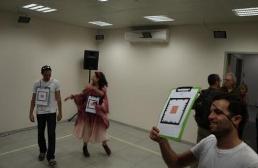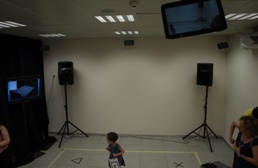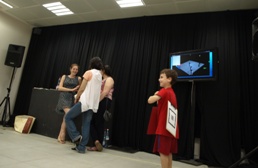What is SoundTracker?
Making music is an arduous process, as any musician will testify. The SoundTracker project enables anyone to experience the process of music making, but in a less demanding and more intuitive way – moving in space.
Like a player studying his instrument, first each person will explore his movement, and understand how it affects the music he creates in the space. And like a band whose members learn to play together, the participant will play with his temporary partners and will have to adapt his movement, and thus his playing, to theirs, in order to achieve harmony.
Overview
The SoundTracker project tracks players inside a room, using Android based tablets. A 3D mapping of the individuals is extracted, which is then used to generate music. Each person plays a role in the group, and his movements in the room (i.e. - his location) dictates how the instruments he controls sound
Our Goal
Our aim is to allow any person to get a sense of playing an instrument, both by himself and as part of a group, in the easiest way possible - by simply moving. We attempt to maintain the balance between controlling the music in order to achieve harmony and giving the players more freedom at the risk of creating a cacophony.
Our Team
-
Developer
-
Developer
-
Electronic music artist
-
Presenter
 Our first and foremost task is to track the players inside the room.
We use Qualcomm's AR SDK in the
Our first and foremost task is to track the players inside the room.
We use Qualcomm's AR SDK in the  Each camera provides a pose matrix for the markers it detected in regards to the camera itself.
The
Each camera provides a pose matrix for the markers it detected in regards to the camera itself.
The  A band is not homogenous, and neither is the music generated by SoundTracker.
As in a band, there are both backup roles and leading roles. The
A band is not homogenous, and neither is the music generated by SoundTracker.
As in a band, there are both backup roles and leading roles. The  In order to help the players recognize the affect of their movement on their instrument, the
In order to help the players recognize the affect of their movement on their instrument, the  Since our tablets are hanging from the ceiling, rebooting them in case the program crashes can be a hassle. In order to tackle this problem, we created
Since our tablets are hanging from the ceiling, rebooting them in case the program crashes can be a hassle. In order to tackle this problem, we created 

